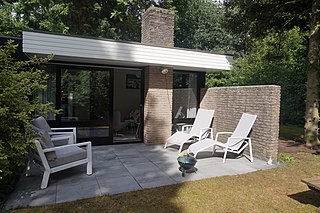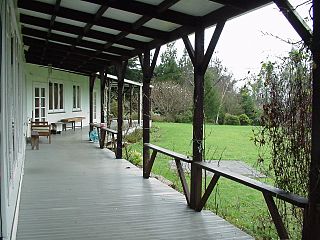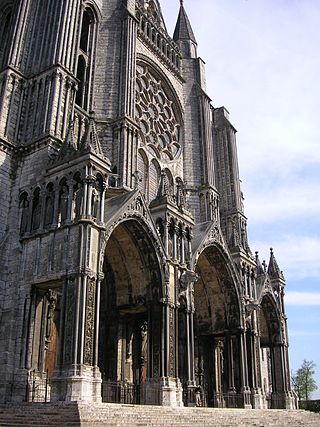
A courtyard or court is a circumscribed area, often surrounded by a building or complex, that is open to the sky.

A futon is a traditional Japanese style of bedding.

A patio is an outdoor space generally used for dining or recreation that adjoins a structure and is typically paved. In Australia the term is expanded to include roofed structures such as a veranda, which provides protection from sun and rain. Pronunciation can vary in Australia as well: patty-oh is perhaps more common generally although payshee-oh may be used by older Australians.

The Edith Farnsworth House, formerly the Farnsworth House, is a historical house designed and constructed by Ludwig Mies van der Rohe between 1945 and 1951. The house was constructed as a one-room weekend retreat in a rural setting in Plano, Illinois, about 60 miles (96 km) southwest of Chicago's downtown. The steel and glass house was commissioned by Edith Farnsworth.

Skidaway Island State Park is a state park near Savannah, Georgia. The park borders Skidaway narrows, a part of Georgia’s intracoastal waterway. Trails wind through maritime forest and past salt marsh, leading to a boardwalk and observation tower. Visitors can watch for deer, fiddler crabs, raccoon, egrets and other wildlife. Inside the park’s interpretive center, birders will find binoculars, reference books and a window where they can look for migrating species such as Painted Buntings.

Ondol or gudeul in Korean traditional architecture, is underfloor heating that uses direct heat transfer from wood smoke to heat the underside of a thick masonry floor. In modern usage it refers to any type of underfloor heating, or to a hotel or a sleeping room in Korean style.

A veranda or verandah is a roofed, open-air hallway or porch, attached to the outside of a building. A veranda is often partly enclosed by a railing and frequently extends across the front and sides of the structure.

A mullion is a vertical element that forms a division between units of a window or screen, or is used decoratively. It is also often used as a division between double doors. When dividing adjacent window units its primary purpose is a rigid support to the glazing of the window. Its secondary purpose is to provide structural support to an arch or lintel above the window opening. Horizontal elements separating the head of a door from a window above are called transoms.

A jalousie window or louvered window is a window composed of parallel glass, acrylic, or wooden louvres set in a frame. The louvres are joined onto a track so that they may be tilted open and shut in unison to control airflow, usually by turning a crank.

The Gropius House is a historic house museum owned by Historic New England at 68 Baker Bridge Road in Lincoln, Massachusetts, United States. It was the family residence of Modernist architect Walter Gropius, his wife Ise Gropius, and their daughter Ati Gropius. The house was designated a National Historic Landmark in 2000 for its association with Walter Gropius, as he was an influential teacher and leader of Modernist architecture. The house includes a collection of Bauhaus-related materials unparalleled outside Germany.

A vestibule is a small room leading into a larger space such as a lobby, entrance hall or passage, for the purpose of waiting, withholding the larger space view, reducing heat loss, providing storage space for outdoor clothing, etc. The term applies to structures in both modern and classical architecture since ancient times. In modern architecture, a vestibule is typically a small room next to the outer door and connecting it with the interior of the building. In ancient Roman architecture, a vestibule was a partially enclosed area between the interior of the house and the street.
An Arizona room is a semi-outdoor recreational room found frequently in homes in Arizona, based on similar concepts as the Florida room. The room is often a patio that has been covered and screened-in, creating an outdoor feeling while preventing excessive heat and keeping insects and animals out. The room generally borders the back yard of the house and is often accessed directly from the living room, kitchen or other common room of the home.

Harold C. Bradley House, also known as Mrs. Josephine Crane Bradley Residence, is a Prairie School home designed by Louis H. Sullivan and George Grant Elmslie. It is located in the University Heights Historic District of Madison, Wisconsin, United States. A National Historic Landmark, it is one of just a few residential designs by Sullivan, and one of only two Sullivan designs in Wisconsin.

Tidewater architecture is a style of architecture found mostly in coastal areas of the Southern United States. These homes, with large wraparound porches and hip roofs, were designed for wet, hot climates.

The Walter V. Davidson House, located at 57 Tillinghast Place in Buffalo, New York, was designed by Frank Lloyd Wright and built in 1908. It is an example of Wright's Prairie School architectural style. The house is a contributing property to the Parkside East Historic District, a neighborhood laid out by renowned American landscape architect Frederick Law Olmsted in 1876, and also a City of Buffalo landmark.

A lanai or lānai is a type of roofed, open-sided veranda, patio, or porch originating in Hawaii. Many homes, apartment buildings, hotels and restaurants in Hawaii are built with one or more lānais.

A screened porch, also known as a screen room, is a type of porch or similar structure on or near the exterior of a house that has been covered by window screens in order to hinder insects, debris, and other undesirable objects from entering the area inside the screen. Typically created to enhance the livability of a structure that would otherwise be exposed to the annoyances of the outdoors, screened porches often permit residents to enjoy an indoor environment outdoors.

A porch is a room or gallery located in front of an entrance of a building. A porch is placed in front of the facade of a building it commands, and forms a low front. Alternatively, it may be a vestibule, or a projecting building that houses the entrance door of a building.

Clock is a timekeeping mobile app available since the initial launch of the iPhone and iPhone OS 1 in 2007, with a version later released for iPads with iOS 6, and Macs with the release of macOS Ventura. The app consists of a world clock, alarm, stopwatch, and timer.

The Elizabeth Murphy House is an American System-Built Home (ASBH), Model A203, designed by Frank Lloyd Wright, and located in the Village of Shorewood near Milwaukee, Wisconsin. The house takes its name from Elizabeth Murphy, wife of loan broker Lawrence Murphy, who purchased a lot as an investment on which to build the house speculatively, and who contracted with Herman F. Krause, Jr., a carpenter, to build the house in 1917 according to plans supplied by Frank Lloyd Wright via Wright's marketing agent for ASBH projects, the Arthur L. Richards Company.



















